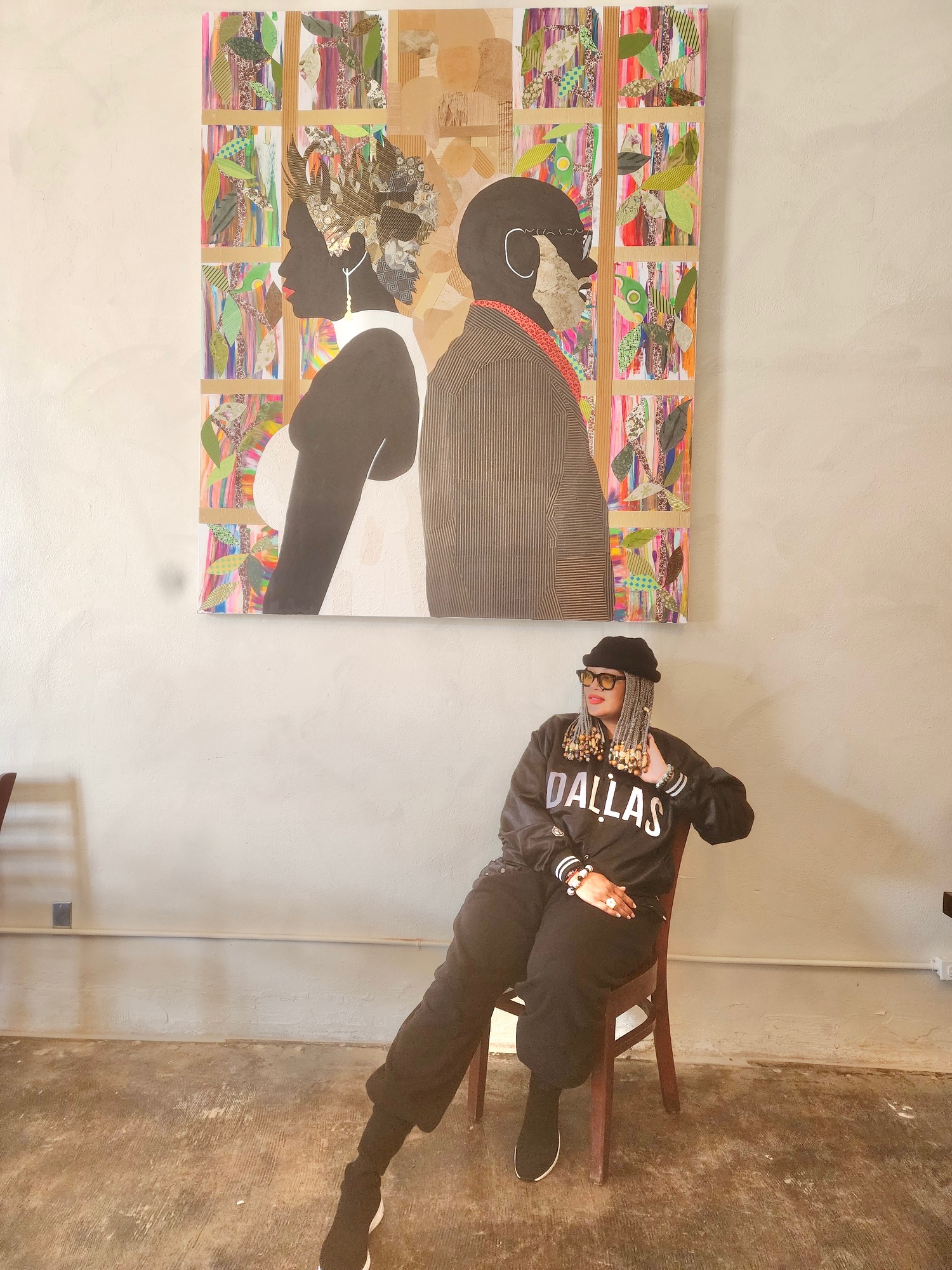
Amber Pickens sits down with Daisha Board, a cultural curator and visionary, on the importance of being custodians of your culture, and investing in artists.
Amber: I got excited when I learned that you were from Queens, NY. I lived in Harlem for over a decade, so NY is a second home for me. So, what was your introduction to art?
Daisha: Oh, goodness—my grandmother. I think my grandmother was definitely my muse. You know, I didn’t realize the amount of art she collected until I was probably out of college. I had graduated from a historically Black college. But I went home after she passed, and I saw some of the artwork she had in her home. She was such a visionary—she had the foresight to say, “These are pieces I love and want to pass down to my family.” I mean, she traveled the world. She was like a living legend from Harlem. If anything, she was my inspiration behind the gallery—to be the custodian of my culture. She collected jewelry, sculptures, and photography, but all of it was like a timestamp of what she saw and experienced in her own life. New York is this bubble of art, culture, and storytelling, and to come here—it was just so, so different.
A: What brought you down here to Texas, especially since there’s so much going on up there? You have people from all around the world, and they celebrate differences rather than trying to make everyone the same. So, what drew you to the South—the deep South?
D: It wasn’t my choice—it was definitely my mother. I’ve always wondered how my life would’ve been if I’d stayed in New York during my formative years. But my mother worked for American Airlines. When they transferred headquarters, we came here, so I spent high school here.
A: Oh wow! You went to high school here?
D: Yes, I graduated from Lamar High School and then went to college in Florida. I think my mother wanted to give us different opportunities and options. She saw that I was interested in sports. You know, sports aren’t as big in the city as they are in the South. So I was able to run track, play volleyball, and basketball—and I’m thankful for that now. Even while working for American Airlines, my mother introduced us to a more global perspective. We saw art and culture from other places—we saw diversity in other cities and countries. So coming here was that bridge I needed—to respond to the times and not just be an “East Coast brat,” but to have a broader perspective. I love it. I’m glad that we’re here. We go back often to see family—most of my family is still in New York. But I always say, I was born in New York and raised in Dallas. So, I have the best of both worlds.
A: Going back to that inspiration for starting the business—because that’s something that often goes undiscussed. People tend to brush over it. It’s one thing to say, “I love art, I’m a collector,” but it’s another to decide, “I want to create a space where we celebrate these pieces and sell them—where we profit from them.” So what were those steps? What did you learn? What was needed—the backing, the resources—and what kept you going through it all?
D: Entrepreneurship is not for the weak—it’s really not. You hear that all the time, but you truly have to have tough skin. This isn’t my first career. This is maybe my third or fourth chapter. I’ve done teaching, real estate, and analytics. But being laid off in 2017—that was my point of no return. I decided I didn’t want to keep working in a space where I didn’t feel appreciated. I couldn’t authentically be myself. I couldn’t show up to a job wearing beads and braids—not even on a casual Friday. So when they let me go in 2017—after nearly 20 years in corporate America and real estate—I was hurt and scared, but I also felt a freedom I hadn’t experienced in a long time. I started going to galleries and museums—taking my kids. I finally had time with them. I wasn’t working 60 or 70 hours a week, hustling to make someone else rich. I slowed down. I learned more about myself and what I wanted the next chapter of my life to look like. Visiting museums and galleries is where I found my voice. Thankfully, I had the support of my partner—my husband—who said, “Take the time you need. If you don’t feel like going back into corporate America, then let’s figure out what’s next.” That time and freedom allowed me to make the decision to follow my love for art. Art became my refuge—it was my respite, my emotional release. We internalize so much trauma in corporate America as Black women, as Black people, especially Black women. And I feel the same in the fine arts space. There’s so much that gets internalized.
A: Absolutely.
D: To have that moment to just enjoy being surrounded by beautiful things—even if I didn’t understand everything at first—I was curious. I wanted to learn. That curiosity connected me to the artists. Thank God for social media. I was new to Instagram, but I started reaching out to artists whose work I loved. I visited their studios, listened to their stories—more than I talked. I wanted to know their challenges and how I could help. On a broader scale—one day, my daughter and I were at the DMA. That was our spot. And she said, “Mommy, I really enjoy coming to these museums, but I honestly don’t see anyone who looks like me here.” She was about eight or nine years old at the time. And she was right. There was no representation. Most of the work we saw revolved around slavery and colonialism.
A: And not even from the perspective of the enslaved people when they talk about slavery.
D: Exactly. That’s when it hit me. Representation is so vital—not just for me as a viewer, but for how we, as a people, continue telling our own stories. If my daughter could recognize that at nine years old, imagine how many generations have been overlooked—not getting that same education or exposure. And that’s it—representation absolutely matters. Seeing ourselves reflected in art and creativity—and being the architects of that—is powerful. Understanding how valuable we are to the conversation and refusing to undermine our voices—that’s what I was searching for. Thankfully, I was able to open the gallery. But it was a process—it was very strategic in how I entered the art community, because I knew I would be one of one.
A: And so, you felt the support from the arts community—
N: Not necessary.
A: Oh, that’s interesting.
D: I definitely felt the support from the artists. But when it came to the art institutions, collectives, donors, and patrons—the people who don’t look like us—it was very much performative. So I had to figure out how to bridge that gap. How could I make our work relevant to the broader conversation?
A: That’s incredible. That’s so important in the arts—across the board. I feel like I’ve experienced so much of that in my own journey through fine arts and entertainment. Those equitable experiences are what so many of us need to be more curious about and dive deeper into. But I get it—it’s jarring and intimidating, especially because, most of the time, you’re one of one. Even when you have those epiphanies, it’s often just you—even in spaces where everyone looks like you. Sometimes you have to convince people that something will benefit all of us, even when not everyone understands it just yet.
D: Mmhhmm.

A: What did it mean to you to see different celebrities—like members of the Dallas Mavericks, Dwight Powell, or Kyrie Irving—not just supporting you, but wanting to share your work?
D: If anything, that’s been one of the highlights of being in this city at this time. Getting that support from people like Dwight Powell and Kyrie Irving—Yes, yes—amazing, right? But let me tell you how that happened. It was all part of God’s plan, not mine. I didn’t actively pursue them. I was part of the Mavs Business Assist Cohort—the inaugural group for entrepreneurs to get mentorship, guidance, and an introduction to the Mavericks and their sponsors. That experience was amazing. It helped me learn more about how to organize my business. Coming from a finance background, it’s one thing to have structure—but it’s another thing entirely to be the captain of your own ship. Wearing all those hats was exhausting, so I leaned on other organizations for guidance and advice. Being part of that cohort was a blessing. My product isn’t an everyday product—it’s fine art, a luxury item. Some of the other businesses in the cohort sold cookies, merch, or body butters—all amazing products—but I sell fine art. My price points range from $5,000 to $50,000. So, I needed to be in spaces where there were high-net-worth individuals—people who could actually afford the work.
Being introduced to the Mavericks was an incredible opportunity, and that was through Cynt Marshall—their former CEO. She was amazing. I’ll never forget—I was in the bathroom before our pitch competition at the end of the program. I was in the top four finalists. I was in the bathroom praying, crying, nervous—anxiety through the roof—and I felt a tap on my shoulder. She said, “Sis, I see you.” I turned around—it was Cynt Marshall. The first Black woman CEO of an NBA team. She told me, “I see you, and I promise I’ll bring you to the table.” She said, “I see what you’re doing, I love what you’re doing, and when the time is right, I’ll make sure you’re there.” Fast forward—I ended up being in the top four, and I won grant funding that allowed me to open my second gallery. I was so thankful—God really blessed me with that opportunity. And before she retired, Cynt delivered on her promise. She called me and said, “Hey, I have something coming up. I just need you to be ready. Bring as much art as possible.” That was on a Sunday. She sent me a DM on Instagram. Then that Wednesday, her assistant called and said, “You’ll be at the Mavericks’ training facility. Bring the art. You’ll set up there.” I loaded up a U-Haul with as much art as I could—some really large pieces. My artists helped me bring everything to the facility. We were setting up a room to curate and display the work, but I had no idea who would see it. I thought maybe a few executives would walk through—but then I heard the basketball players finishing up training in the gym. Suddenly, Cynt told me, “You’re going to present in front of the team—the whole team. They asked for you. They want to learn about art from you.” I was like, “Oh my God.” So there they were—Kyrie, Luka, everyone—in this classroom. I started telling them about what we do, the artists we support, the community, the importance of being custodians of your culture, and investing in artists. We had one piece displayed in that classroom, and Kyrie said, “That’s mine.” I didn’t even get to tell him the price. Other players started asking, “Wait—are we bidding on it?” They didn’t even know how it worked! It was so exciting. We brought them into the room to see all the art, and their eyes just lit up—they were like big kids. Of course, they’re high-net-worth individuals, but even then, many of them had never been introduced to art in that way before. They were genuinely excited. Klay Thompson purchased a piece, the Mavericks organization bought one, and Kyrie ended up purchasing five. Later, one of the players even rented out the entire gallery for his wife’s birthday dinner—and they bought two pieces. It was their first art acquisition. It was beautiful. I was strategic from the beginning. I knew my business wasn’t a typical one for that cohort, but I made sure to stand out with authenticity. And that led to this incredible success story. Dwight’s an amazing collector. Kyrie is too. But more than that, I’m so proud of what our artists are doing—translating their stories into these opportunities and becoming part of such powerful collections.
A: Incredible. On a personal note, this is inspiring me too. It’s awesome learning more about your journey, because I’ve been watching from afar, and it’s really cool to hear directly from you how amazing this experience has been. So, what’s been your biggest lesson? You’ve had so much happen in such a short time—you’re still expanding, still evolving. What has being an entrepreneur taught you?
D: Oh, goodness. I’d say the biggest lesson is to keep being a student—to keep learning as much as possible—and not to let other people’s fears or insecurities influence your vision. God didn’t give it to anyone else. And it’s hard sometimes to convince people that this is what you’re meant to do. Even my closest friends, even some people within the art community—they tiptoe around what they really want to do because they’re afraid of disrupting the norm or creating discourse. But I’m okay with that. You can’t tell me I can’t do something—especially when I know I’ve been led to do it. If I didn’t feel called, maybe I’d hesitate. But when you know that something inside you is telling you this is your purpose and passion—you have to follow it. So that’s it: keep learning, keep growing. If I have to pivot, that’s okay—that’s part of life. There’s no blueprint for me. I’m creating the blueprint as I go. Every challenge and every turn teaches me something new. So the most important lesson? Keep learning, keep growing, and keep being a visionary in this field.


